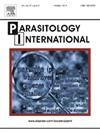巴基斯坦囊性棘球蚴病:人囊分离物细粒棘球蚴的鉴定和基因分型
IF 1.5
4区 医学
Q3 PARASITOLOGY
引用次数: 0
摘要
很少有研究分析巴基斯坦囊性包虫病(CE)的现状。该研究旨在从分子特征上描述巴基斯坦开伯尔-普赫图赫瓦省(KP)的人类棘球蚴感染。2007-2021年期间,从KP白沙瓦的四家主要医院共收集了251个福尔马林固定石蜡包埋(FFPE) CE囊肿,并收集了患者的临床数据。成功提取了包含106个样品的基因组dna (gDNA)。采用多重PCR和实时PCR检测棘球蚴。106份标本均为粗感颗粒绦虫,为严格感颗粒绦虫。进一步的SNP基因分型分析显示G1(79.3%)基因型比G3(20.7%)基因型更为普遍。研究指出,颗粒棘球绦虫s. G1基因型是白沙瓦地区囊性棘球蚴病(CE)的主要病原,绵羊是主要传播源。这些发现强调了14年来人类与牲畜相互作用所造成的持续的人畜共患病风险。获得保健设施进行早期诊断和治疗的机会有限,居民对疾病认识不足,以及传统的牲畜管理做法,可能被认为是造成该地区人类疾病持续存在的主要因素。为了减少该病对人类健康的影响和牲畜的经济损失,进一步的流行病学研究对于支持巴基斯坦针对这种人畜共患疾病的有效控制规划至关重要。本文章由计算机程序翻译,如有差异,请以英文原文为准。
Cystic echinococcosis in Pakistan: Identification and genotyping of Echinococcus Granulosus Sensu Stricto in human cyst isolates
Few studies have analysed the current status of cystic echinococcosis (CE) in Pakistan. The study aimed to molecularly characterise Echinococcus infections in humans in Khyber Pakhtunkhwa (KP), Pakistan. A total of 251 formalin-fixed, paraffin-embedded (FFPE) CE cysts, with the clinical data of patients, were collected from four major hospitals in Peshawar, KP, during 2007–2021. The genomic DNAs (gDNA) containing 106 samples were successfully extracted. A multiplex PCR and a real-time PCR assay were performed to detect Echinococcus species. All 106 samples were confirmed as E. granulosus sensu lato and identified as E. granulosus sensu stricto (s.s.). Further analysis by using SNP genotyping showed that the G1 (79.3 %) genotype was the most prevalent compared to G3 (20.7 %). The study pointed out that E. granulosus s.s. G1 genotype is the primary cause of cystic echinococcosis (CE) in Peshawar, highlighting sheep as a major transmission source. The findings underscore the persistent zoonotic risk due to human-livestock interactions over 14 years. The limited access to healthcare facilities for early diagnosis and treatment, poor awareness about the disease among the population, and traditional livestock management practices may be possibly considered as the major factors causing the persistence of human disease in this area. To reduce the disease's impact on human health and economic losses in livestock, further epidemiological studies are essential to support effective control programs against this zoonotic disease in Pakistan.
求助全文
通过发布文献求助,成功后即可免费获取论文全文。
去求助
来源期刊

Parasitology International
医学-寄生虫学
CiteScore
4.00
自引率
10.50%
发文量
140
审稿时长
61 days
期刊介绍:
Parasitology International provides a medium for rapid, carefully reviewed publications in the field of human and animal parasitology. Original papers, rapid communications, and original case reports from all geographical areas and covering all parasitological disciplines, including structure, immunology, cell biology, biochemistry, molecular biology, and systematics, may be submitted. Reviews on recent developments are invited regularly, but suggestions in this respect are welcome. Letters to the Editor commenting on any aspect of the Journal are also welcome.
 求助内容:
求助内容: 应助结果提醒方式:
应助结果提醒方式:


